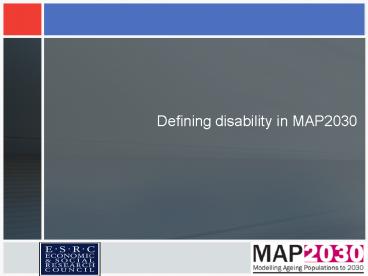Defining disability in MAP2030 PowerPoint PPT Presentation
1 / 15
Title: Defining disability in MAP2030
1
Defining disability in MAP2030
2
Rationale
- Disability is used as an input to or output from
every WP - A variety of data sources (surveys) are used by
each WP - Not complete overlap between disability items in
each of the surveys - Aim to agree definition of disability that is
comparable between surveys and therefore WPs
3
What is disability?
Models of the disablement process
DiseasegtImpairmentgtFunctional
limitationgtDisability (Nagi, 1965,1976, 1991)
DiseasegtImpairmentgtFunctional gtActivity
RestrictiongtHandicap
limitation (Wood, 1975)
DiseasegtImpairmentgtDisabilitygtHandicap (ICIDH,
1980)
4
Components
- Functional limitations
- Reaching, stretching, lifting, dexterity
- Household Activities (IADL)
- Shopping, cooking, housework, managing affairs
- Personal Care Activities (ADL)
- Bathing, dressing, feeding, getting in and out of
bed, using toilet - Mobility
- Getting up and down stairs/steps, walking across
a room, walking half a mile, getting around
outside
5
Surveys
- General Household Survey (GHS)
- A multi-purpose continuous survey of people
living in private households (approx 13,000
household sampled) in Great Britain. Started in
1971 and has been carried out continuously since
then, except for breaks in 1997/98 and 1999/2000.
All adults aged 16 and over are interviewed in
each responding household. Demographic and health
information is also collected about children in
the household. - English Longitudinal Study of Ageing (ELSA)
- A panel study of 11,500 people aged 50 and older,
drawn from the Health Survey for England and
interviewed every two years (since 2002) with a
nurse visit every four years. - British Household Panel Study (BHPS)
- Annual survey consisting of nationally
representative sample of about 5,500 households
recruited in 1991. Individuals re-interviewed
each year, still followed if they split off from
original households, new members to household
included as are all adult members of the
household so the sample remains representative.
Additional samples recruited later mean the study
now covers the whole UK. Now contains total of
approximately 10,000 interviewed individuals. - MRC Cognitive Function and Ageing Study (CFAS)
- Longitudinal study of 13,004 aged 65 in 5
centres 1991-2001 includes institutionalised
6
Comparison of items in surveys
7
Standardised prevalence of disability
(difficulty) age 65
8
Standardised prevalence of disability
(difficulty) age 75
9
Standardised prevalence of disability (help) age
75
10
Hierarchy of items (CFAS) - longitudinal
11
Hierarchy of items (CFAS) by gender
12
Why differences might occur
- Filters
- If cannot manage steps/stairs can . (GHS)
13
Effect of filtering by difficulty with stairs
women aged 75
14
Why differences might occur
- Filters
- If cannot manage steps/stairs can . (GHS)
- Question wording
- Because of a health or memory problem (ELSA)
- Responses
- Very easy, fairly easy, fairly difficult, very
difficult (GHS, BHPS) - No difficulty, some difficulty (CFAS)
- Position of question in survey
15
Next steps
- Obtain standardised prevalence (help) for BHPS
items - Review cross-sectional hierarchy for each survey
- is ordering the same regardless of items?
- Explore longitudinal hierarchy for BHPS?
- Try to find equivalent arrangement across surveys
for difficulty with 1 or more items

